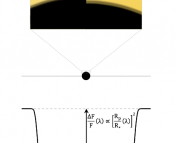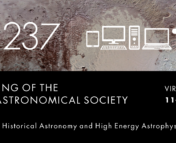Title: A secondary atmosphere on the rocky exoplanet 55 Cancri e
Authors: Renyu Hu, Aaron Bello-Arufe, Michael Zhang, et al.
First Author’s Institution: Jet Propulsion Laboratory, California Institute of Technology, Pasadena, CA, USA
Status: Published in Nature [Open access]
Much like our Earth, exoplanets can have atmospheres – under the right conditions. The authors of today’s paper find evidence of an atmosphere on 55 Cancri e, a lava-filled super earth in a very impressive solar system.
The Star (or, rather, Planet) of the Show: 55 Cancri e
The 55 Cancri system has a lot going on. Like our sun, the star 55 Cancri is the host to many different planets (in fact, it was the first system outside of our solar system known to host 5 exoplanets), but this system could not be more different than our own. Aside from 55 Cancri d, which orbits 55 Cancri with a semi-major axis similar to Jupiter’s, the four inner planets (Canri b, c, e, and f)) could all fit inside the distance between our Sun and the Earth. 55 Cancri e (55 Cnc e, for short) was discovered in 2004, making it the fourth exoplanet discovered in this system – but it also happens to be the closest known planet to 55 Cancri, with an orbital period of just 0.7 days. That means that every year on this planet is less than 1 day on Earth! Because of the proximity to its host star, 55 Cnc e is tidally locked, meaning that it takes precisely as long for 55 Cnc e to rotate on its axis as it does to orbit its star. As a result, there exists a permanent dayside and permanent nightside on 55 Cnc e – and the dayside temperature gets hot, hot, hot! So hot, indeed, that its dayside is believed to be completely covered in a magma ocean. It was previously assumed that a rocky planet like this with a blistering hot dayside temperature would have a difficult time holding onto its atmosphere, and eventually lose it completely, but the authors of today’s paper make a groundbreaking discovery that challenges that assumption.
Mighty Mighty Spectroscopy!
The authors of today’s paper use two instruments on JWST, NIRCam and MIRI, to observe 55 Cnc e. Both of these instruments can be used for spectroscopy, and therefore have the ability to detect the presence of an atmosphere and identify its composition by looking at the emission lines. However, this is really hard to do for a planet that is so close to its host star, as the host star’s atmosphere is so bright relative to that of the planet, making it hard to tell which feature is coming from the star and which is coming from the faint planet. To combat this issue, the authors take emission spectra of 55 Cnc e before, during, and after its secondary eclipse – that is, when the planet passes behind its host star (see Figure 1). By subtracting the light during the secondary eclipse (i.e., the light from just the star) from the combined light measured from the star and planet together, the authors can produce a spectrum consisting solely of contributions from the planet’s atmosphere. This is known as thermal emission spectroscopy.

Figure 1: The secondary eclipses of 55 Cnc e. As the planet passes behind the star, the light from the planet is blocked, causing a “dip” in brightness. This secondary eclipse was detected in both NIRCam and MIRI, which observe the star in two different wavelength bands. Figure 1 in the paper.
Atmospheric Modeling
The thermal emission spectrum provides us with a lot of information. First, the authors are able to determine the molecules most likely present in the atmosphere through a method known as atmospheric retrieval. Using this method, the authors are able to infer the properties of the exoplanet’s atmosphere by comparing its spectrum to model spectra that explore the range of possible atmospheric molecular compositions. The authors first fit the data with a blackbody to establish the null hypothesis (i.e. no atmosphere), and then test out models containing combinations of H2O, CO, CO2, N2, O2, SO2 or SiO. They found using CO2 as a single-gas composition and using a combination of CO2, CO and N2 both result in models that are preferred over the null hypothesis (see Figure 2). They further tested this result by creating a separate set of self-consistent atmospheric models, and found that the best fit models contain the presence of CO and CO2. Therefore, the authors conclude that regardless of the model, they have robust detections of a CO and/or CO2-rich atmosphere.

The Climate on 55 Cnc e
So now we know that this tidally locked super earth has compelling evidence of a carbon and oxygen rich atmosphere, but there is so much more to discover. The authors also used these measurements to calculate a brightness temperature – the temperature a blackbody would have in order to emit the observed spectral radiation – of 1,796 ± 88 K, which was much lower than expected. As mentioned previously, the day side of this planet is constantly cooking, while its nightside is in perpetual darkness. But this cooler-than-expected temperature indicates that 55 Cnc e’s atmosphere is not stagnant – but rather successfully redistributing heat from the dayside to the nightside. This redistribution is crucial because without it, we would expect the atmosphere to completely be stripped away by the extreme irradiation.
This discovery shows that 55 Cnc e is more than just a lava world, but rather a complex system with a robust climate that deserves more attention. These techniques will also pave the way to better understanding the climates on potentially habitable worlds, helping to answer the questions about life on other planets.
Astrobite edited by Maria Vincent
Featured image credit: NASA/JPL-Caltech




